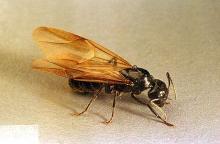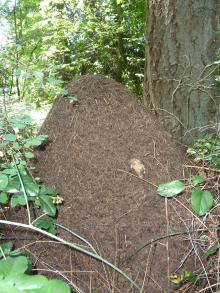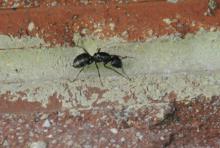Many species, including
Carpenter ant (Camponotus spp.)
Moisture ant/cornfield ant (Lasius spp.)
Odorous house ant (Tapinoma sessile)
Pavement ant (Tetramorium immigrans)
Velvety tree ant (Liometopum spp.)
Thatching ant (Formica obscuripes)
Yellow ant (Acanthomyops spp.)
Pest description and damage Small, red to black. Constricted in midsection. When winged, forewings are larger than hind wings. Ants may establish nests outside, underneath the house, or in wall voids, etc. Control recommendations can vary with species; proper identification is important.
Management
Seal cracks and crevices where ant may enter structures. Entry points include window and door frames and pipe and wiring chases. Trim outdoor plantings away from the structure and keep landscaping materials such as compost or bark mulch from contacting the siding. Pesticide baits are the best way to combat ants in the structure, especially odorous house ants. Follow label instructions carefully. Be patient: baits may require several weeks to be effective. Over-the-counter pesticide sprays are highly repellent to ants and may scatter ants throughout a structure. Carpenter ants may not respond as well to baits; services of a licensed pest control professional may be advisable.
See also
For further information:
Ants/Integrated Pest Management/School IPM. Washington State University. https://schoolipm.wsu.edu/ants





